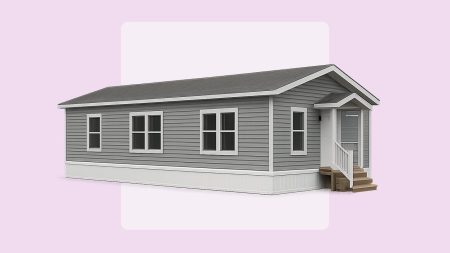Key takeaways
- When you owe more on your mortgage than your house is worth, your mortgage is “underwater,” or in a state of negative equity.
- Being underwater on your mortgage can make it more difficult to sell the home or refinance.
- If you have an underwater mortgage, your options include staying put and waiting for the home to appreciate, trying to get a new loan or requesting a short sale.
What is an underwater mortgage?
“Being underwater or upside-down on a home, car or any other asset means that you owe more than the current value,” says Greg McBride, chief financial analyst at Bankrate. That is: The asset is worth less than the amount you borrowed to buy it, or the amount of the debt you still have to repay.
If you buy a house when prices are high and the real estate market then retreats, your home’s value can depreciate, or shrink. As a result, you could wind up with a mortgage balance that outstrips that value. When that happens, you’re considered underwater on your mortgage. It’s also known as having negative equity.
For example, say Jane bought her home for $300,000, made a $30,000 down payment and borrowed $270,000. Two years later, a recession hits her city and Jane becomes unemployed, but has an excellent job opportunity in another state. She needs to sell her house and move, but she learns that home values in her area have declined and her house now has a market value of $250,000 — and, she still owes $258,400 on her mortgage. She is now underwater, or upside-down, on the mortgage.
How does an underwater mortgage happen?
An underwater mortgage can happen in any of the following situations:
- During times of economic downturns: Underwater mortgages usually occur during an economic downturn when home values fall. For example, during the 2007-8 subprime mortgage crisis, many borrowers ended up owing much more than their homes were worth.
- Selling a home soon after buying with a low down payment: Buying a home with little or no money down can leave homeowners upside-down if they try to sell soon after purchasing. “Even a stagnant home price can leave you upside-down if you wish to sell the home soon after, because the transaction costs of selling could more than offset what little equity you have,” says McBride.
- Taking out a second mortgage: If you take out a second mortgage that depletes most or all of your ownership stake, it can also cause an underwater mortgage.
Housing values can also decrease due to rising interest rates, high numbers of foreclosures or natural disasters.
Signs that your mortgage is underwater
Keep an eye out for these signs that might indicate you’re underwater on your mortgage or at risk of it:
- Home values are dropping in your area. If property values for similar homes nearby are decreasing, your home’s value might be lower than what you owe.
- Your home appraisal comes in low. You can use a home value estimator tool to get a ballpark idea, but to know for certain, get a home appraisal. Once you know the value, you can use your mortgage statements to determine whether your loan is upside-down.
- You’re struggling to keep up with mortgage payments. Falling behind on your payments can be a sign of deeper financial trouble, especially if your home’s value has fallen and refinancing isn’t possible.
Why an underwater mortgage can be risky
While the idea of being underwater on your mortgage sounds scary, if you’re planning to stay in your home, it doesn’t have to impact your day-to-day life. Most borrowers can keep making their payments and “over time can get right-side up by paying down some of the principal balance and/or seeing some appreciation in the price of the home,” says McBride.
Still, there are some times when a homeowner should be concerned about being upside down on their mortgage. These times of risk include:
- Refinancing: People who find themselves in hardship might find it nearly impossible to refinance, unless they qualify for a government program or certain types of mortgages, says Bruce McClary, spokesperson for the National Foundation for Credit Counseling, a Washington, D.C.-based nonprofit organization.
- Selling: Trying to sell your home if you’re underwater can put you at risk of needing to pay the difference if you can’t make enough from the sale to cover your mortgage balance. Alternatively, you’ll need to apply for a short sale with your lender, in which the bank agrees to accept less than the total remaining mortgage balance out of the sale proceeds.
- Losing the home: When a home is underwater, you are at a higher risk of foreclosure if the payments become too much for you.
What to do if you’re underwater on your mortgage
If you find yourself underwater on your mortgage, you’ve got several options to consider.
1. Stay in the home and build equity
In an upside-down mortgage situation, you can choose to stay in your home and continue to make payments to reduce the principal balance on the loan.
“Essentially, you’re riding out the market until values take a turn and go higher,” says Lott. “During this time it would be beneficial to make extra payments on the principal balance of the loan while waiting for home values to rise.”
2. Explore new financing
You have fewer refinancing options if your loan is underwater, but you might not be totally out of luck. Talk to some mortgage refinancing lenders to see what, if anything, you can do to refi your upside-down mortgage. If your original loan is an FHA loan, you might be able to qualify for an FHA streamline refinance.
Unfortunately, Home Affordable Refinancing Program (HARP) loans were sunset in 2018, and Fannie Mae’s High Loan-to-Value (LTV) program has been suspended.
3. Consider a short sale
You might also take the short-sale route to avoid foreclosure and move to a more affordable housing situation, says McClary.
In a short sale, the lender must agree to accept less than the amount owed on the mortgage, making it a loss for them, says Lott. Lenders will only consider a short sale as a final option before foreclosure. Be warned, however, that this type of transaction harms your credit score.
4. Walk away from your mortgage
Another option is to simply walk away from the mortgage — a move called a “strategic default” — but, like a short sale or foreclosure, doing so can be damaging to your future homeownership prospects and credit score. In short, this option also puts you in a precarious financial situation. If you walk away, your lender could even hold you liable for repaying the debt.
Homeowners should obtain advice from a HUD-approved nonprofit housing counseling agency in these situations to “help identify solutions specific to your circumstances and community,” says McClary. There might be a way to resolve your situation besides walking away, which is really a last resort.
5. Let the lender foreclose
Finally, you could let your lender begin the foreclosure process on your home. Once this process is complete, the lender regains the home from the homeowner, who walks away from the property with their debt wiped clean but with a damaged credit score. Many people in foreclosure also file for bankruptcy to eliminate other debts.
There are long-lasting repercussions for these options, says Lott. A bankruptcy and foreclosure can stay on your credit report for 10 years, and, like the other options, limit your ability to buy another home for several years.
Underwater mortgage FAQ
Read the full article here












